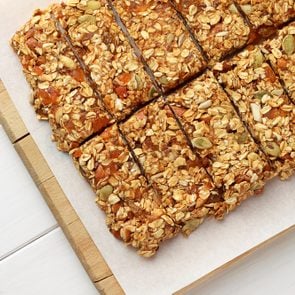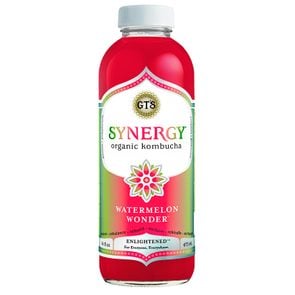Not a Fan of Cauliflower Rice? This Will Change Your Mind
Updated: Jul. 30, 2021
Here's what you need to know about cauliflower rice, including nutrition, calories, carbs, and how to cook it. Added bonus: Two delicious, globally-inspired cauliflower rice recipes to try.
Our editors and experts handpick every product we feature. We may earn a commission from your purchases.
Another brilliant way to eat cauliflower
It’s true that swapping cauliflower rice in place of traditional rice is a bit of a fad, and one that not everyone is crazy about.
However, cauliflower rice is actually tasty, not overly expensive, relatively fast to fix, and easily fits into most eating plans. We’d call that a trend worth trying.
Here’s what to know about this gluten-free, low-carb vegetable dish, including its calories, carbs, and nutrition benefits. Plus, we’ve added some cauliflower rice recipes to try at home.
What is cauliflower rice?
Cauliflower rice may look just like white rice (and sometimes like couscous), but it tastes 100 percent like cauliflower. That’s because it is 100 percent cauliflower. It’s just finely chopped, usually in a food processor, to the size of rice kernels.
However, since cauliflower is a mild-tasting vegetable, it can be somewhat chameleon-like and seem just like rice after adding spices and seasonings.
Whether you prepare it rather plainly, like typical rice pilaf, or spiced up, like Spanish rice, you can serve it just like you serve rice. As a bonus, it goes from prep to plate quickly.
Cauliflower rice is “hot”
It’s a popular pick. Sales stats back that up. Google Trends finds that searches for “cauliflower rice” in the U.S. didn’t start really gaining momentum until January 2014.
According to a Neilsen report, while fresh cauliflower sales saw a slight decline in 2017, sales of cauliflower alternatives, like cauliflower rice, doubled from the previous year.
And there’s been continued interest since. In fact, it’s one of the most popular healthy alternatives that nutritionists trust. Of course, there’s been tremendous growth in all types of cauliflower products (hello cauliflower-crusted pizza).
The highest spike to date for “cauliflower rice” searches in the U.S. is January 2021, based on Google Trends findings—with Connecticut being the state with the highest interest. These peaks in interest tend to happen every January, when many people start healthy (and not-so-heathy) diets.
And if you’ve been dining out recently, you’ve likely seen “cauliflower rice” on an increasing number of menus, especially when the restaurant features items for different diet styles. For instance, Chipotle introduced cilantro-lime cauliflower rice in 2021, which aligns with their “Lifestyle Bowls.”
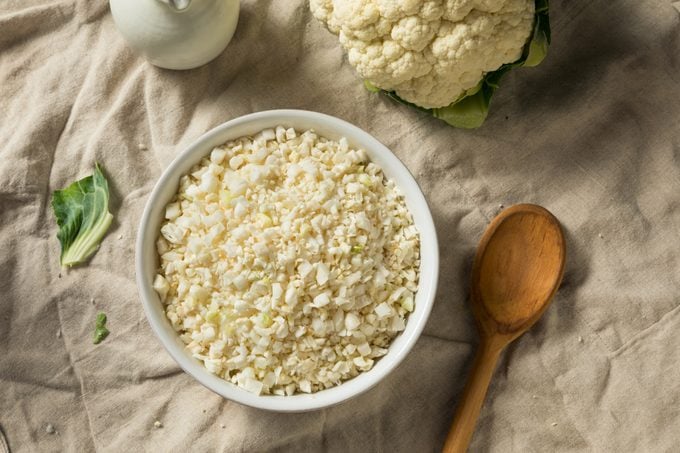
How to make cauliflower rice
To make cauliflower rice, ideally start with a fresh whole head of cauliflower.
Trim off the leaves and thick stalks. Then cut the remaining cauliflower into large florets.
Add them to a food processor, filling it no more than three-quarters full.
Do this in batches if you need for the most evenly-sized results. Press the pulse button several times, usually less than 10 times, until you reach desired rice-like consistency. Now you’ve got cauliflower rice that’s ready for cooking.
Other methods include using a blender, box grater, molcajete, or just a chef’s knife and cutting board.
Alternatively, you can go for a shortcut and buy fresh or frozen cauliflower that’s already riced for you.
How to eat cauliflower rice
Want to start with the basics? For a simple sautéed cauliflower rice, heat a little oil in a cast iron or other stick-resistant skillet over medium-high heat.
When the oil shimmers, add the cauliflower rice and sauté until desired brownness, about eight to 10 minutes. Then season as you wish and enjoy wherever you normally serve rice.
Prep tips
- Make sure the skillet is fully preheated and that you’re using a large enough skillet (hint: a wok works well) so that the cauliflower rice actually sautés rather than steams.
- If you don’t have a large skillet, consider wrapping the fresh cauliflower rice in a clean kitchen towel and squeeze any excess liquid you can from it before cooking. This will help with proper caramelization (browning).
- Don’t skimp on oil. It helps you achieve that delicious caramelization.
- Keep in mind that just like you can eat raw cauliflower florets, you can eat cauliflower rice raw. Plan to pair it with high-flavored foods, like a spicy Thai ginger-peanut “grain” bowl, for the most enjoyable cuisine experience.
- And don’t forget to use all of the cauliflower parts to prevent food waste. The stalks and leaves can be sliced and added to soups or stir-fries.
Is cauliflower rice good for you?
Yes, cauliflower rice can be tasty. But is it healthy, too? The quick answer to that is an absolute yes.
While rice, especially whole grain brown rice, is a nutritious food, cauliflower rice provides an option that cup-for-cup is significantly lower in calories and carbs and higher in vitamin C, plus offers unique nutrient benefits.
Cauliflower nutrition facts
A one cup serving of chopped raw cauliflower florets, which is equivalent to 3.77 ounces (107 grams) of cauliflower rice, provides the following nutrients:
Calories: 27
Fat: 0.3 g (<1 percent daily recommended value, or DV) Sodium: 32 mg (1 percent DV)
Total Carbohydrate: 5.3 g (2 percent DV)
Dietary Fiber: 2.14 g (8 percent DV)
Sugars: 2 g
Protein: 2 g (4 percent DV)
Vitamin C: 51.6 mg (57 percent DV)
Choline: 47.4 mg (9 percent DV)
Calcium: 23.5 mg (2 percent DV)
Iron: 0.45 mg (2.5 percent DV)
Potassium: 320 mg (7 percent DV)
Health benefits of cauliflower
Cauliflower, including cauliflower rice, sure puts the false notion that “white foods are unhealthy” to rest. It’s definitively a health-protective winner.
It’s low in calories and carbs
Some people may need to keep calorie or total carbohydrate intake in check, like those living with type 2 diabetes.
Since cauliflower rice is significantly lower in calories and carbs than traditional rice, it’s a definite benefit for people that fit into this diet category.
It’s rich in vitamin C
In the raw form, cauliflower rice is an excellent source of vitamin C. Surprisingly, one serving of cauliflower rice (51.6 mg vitamin C) provides the same amount of the nutrient as one small orange (51.1 mg vitamin C).
That means it can offer you all of the same antioxidant and immune-strengthening benefits, while potentially reducing the risk of mortality from cardiovascular disease, per research in the International Journal of Molecular Sciences and Nutrients.
It’s good for the gut
It’s all in the family. Since cauliflower is part of the Brassica family of plants and classified as a cruciferous veggie, it means cauliflower rice is, too.
According to a study published in Molecular Nutrition & Food Research, following a Brassica‐rich eating plan may offer potential gastrointestinal (GI) health benefits due to its effect on the gut microbiota (or microbiome).
A key reason for this is that these vegetables contain a significant amount of the prebiotic inulin, which is a fermentable fiber that helps feed good bacteria in the gut, per the American Journal of Clinical Nutrition.
Plus, even if you’re enjoying cauliflower rice just like a grain, it helps boost your overall veggie intake. And let’s face it, some folks need all the help they can get.
It may reduce risk for cancer
What’s old news is new news. Cruciferous vegetables, like cauliflower, have long been associated with cancer prevention. And there’s updated research to support this connection.
A research review published in Molecular Nutrition & Food Research suggests that bioactive isothiocyanates (naturally occurring molecules) found in cruciferous veggies may play a role in preventing and treating bladder cancer.
What’s more, research published in the peer-reviewed journal Nutrition and Cancer finds that consuming raw cruciferous vegetables may lower your risk for getting stomach cancer.
There’s still so much to learn about the health-protective and disease-fighting roles of plant nutrients.
But, here’s one researched tidbit: A review in F1000 Research points to indole-3-carbinol, the breakdown product of a phytochemical found in cruciferous veggies, which may have anti-cancer properties. It’s considered a phytohormone–or plant hormone.
It’s a grain-free alternative
Rice is gluten-free—and so is cauliflower rice. That means for people or who can only eat select grains, like those with celiac disease or a gluten intolerance, cauliflower rice provides them one more grain-style option to indulge in.
Also, for people who choose to limit their grain intake, like those following a keto or Whole30 diet, it offers them a way to do “rice” without the extra carbs. Though the questionable health benefits of these diets are another matter.
Tips for buying cauliflower
You can find U.S. organically- or conventionally-grown fresh cauliflower in farmer’s markets and supermarkets all year long, which makes it easy to savor cauliflower rice dishes any time you wish.
When buying it, look for cauliflower heads that are firm and compact with tightly attached leaves. Store in the fridge for up to a week.
And don’t just choose white cauliflower. Be on the lookout for orange, purple, and green varieties, too. The green variety is also called Broccoflower. And don’t worry, nothing funky is added to get these gorgeous shades. They all taste the same, but you do get a boost of antioxidants in the orange and purple varieties.
Buying any color of cauliflower and making your own cauliflower rice is simple.
But if you prefer simpler, peruse your local supermarket for deli-prepared riced cauliflower, fresh packaged riced cauliflower, frozen riced cauliflower, frozen riced cauliflower mixed with other veggies, and frozen prepared cauliflower rice dishes, like stir-fried cauliflower rice.
Cauliflower rice and traditional rice can coexist
While cauliflower rice can be served in place of rice, most people can absolutely enjoy both cauliflower rice and traditional rice.
For instance, plan for cauliflower rice when the rest of the meal is starchy, like a veggie burger on a big bun with corn on the cob. And if there’s no other high-carb food in the meal, like wild salmon with asparagus, brown rice would be quite nice as a pairing.
In fact, you might actually want to call cauliflower rice something other than “rice,” so you think of both foods in separate, enjoyable, and healthful ways. Some simply call it riced cauliflower. But you can give it a unique name that suits your style, like blitzed cauliflower, cauliflower gems, or pearls of cauliflower.
Simple ways to enjoy cauliflower rice
No matter what you call cauliflower rice, enjoy it in these delightful ways:
- Sauté, flavor as you wish (try lime zest, garlic, and cilantro or lemon zest, chives and dill), and serve as a simple side
- Stir-fry it as the “rice” of fried rice
- Simmer it into any soup to add rice-like texture and veggie goodness
- Cook it with marinara sauce to create a Bolognese-style pasta sauce
- Try it raw in place of any grain as a salad, like tabbouleh
Finally, I highly recommend trying my flavorful, globally-inspired cauliflower rice side dishes, Coconut Cauliflower Rice and Mexican-Style Cauliflower Rice. They’re sure to be the star of your plate.
Coconut Cauliflower Rice
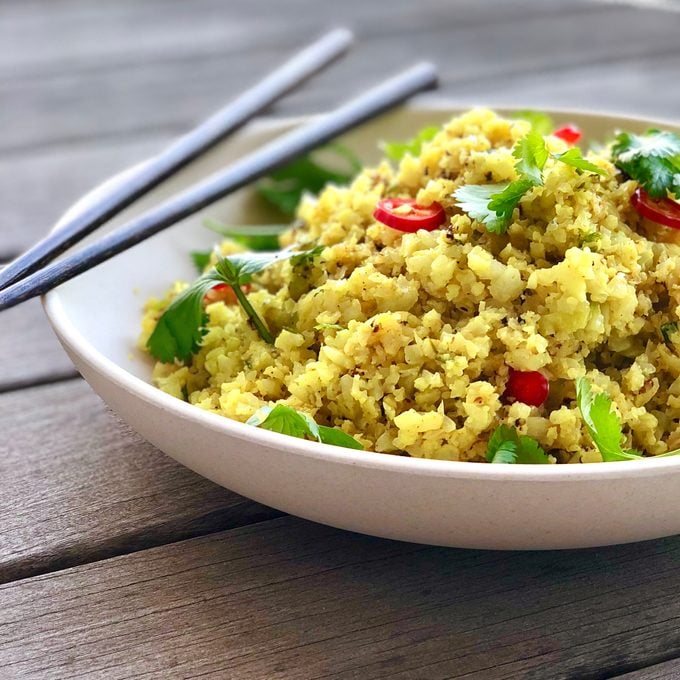
Recipe courtesy of Jackie Newgent, RDN, CDN
Serves: 4
Serving size: 1 cup each
Ingredients:
1 large head cauliflower, trimmed and separated into large florets
2 tablespoons virgin coconut oil or avocado oil
1/4 cup (60 milliliters) organic coconut milk
3 scallions, green and white parts, minced
3/4 teaspoon fresh grated turmeric root
3/4 teaspoon sea salt, or to taste
1/4 teaspoon freshly ground black pepper, or to taste
1/4 cup fresh cilantro leaves and tender stems (or microgreens)
1/2 small red hot chili pepper, thinly sliced (optional)
Instructions:
In two batches, pulse the cauliflower florets in a food processor until the size of couscous. (Makes seven to eight cups uncooked riced cauliflower.)
Add the coconut oil, coconut milk, scallions, turmeric, salt, and pepper to an extra-large cast-iron skillet or a wok and heat over medium-high. Add the riced cauliflower and cook while stirring until golden brown, about 12 minutes.
Adjust seasoning, sprinkle with cilantro and hot pepper (if using), and serve.
Per serving: 140 calories, 10g total fat, 9g saturated fat, 0g trans fat, 0mg cholesterol, 490mg sodium, 10g total carbohydrate, 4g dietary fiber, 4g total sugars includes 0g added sugars, 4g protein
Mexican-Style Cauliflower Rice
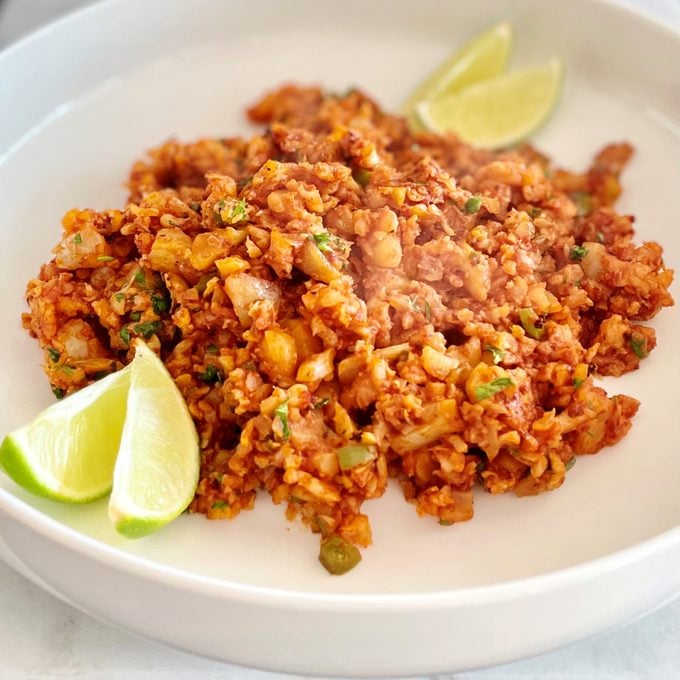
Recipe courtesy of Jackie Newgent, RDN, CDN
Serves: 4
Serving size: 1/2 cup each
Ingredients:
2 tablespoons avocado oil or sunflower oil
1 medium head fresh cauliflower (about 20 ounces/567 grams), trimmed and separated into large florets
1 small jalapeno pepper, seeded and finely chopped
1 garlic clove, minced
3/4 cup (190 grams) tomato sauce
1/2 tsp sea salt
1/8 teaspoon ground cumin
1 tablespoon finely chopped fresh cilantro
4 lime wedges
Instructions:
Pulse the cauliflower florets in a food processor until the size of rice. (Makes about 4 cups/454 grams uncooked riced cauliflower.)
Fully heat the oil in an extra-large (12-inches or larger) cast iron or other stick resistant skillet over medium-high. Add the riced cauliflower and sauté until lightly browned, about 8 minutes. Add the jalapeno and garlic and sauté until the cauliflower is brown, about two to three minutes more.
Add the tomato sauce, salt, and cumin, and cook while stirring until the tomato sauce is absorbed by the cauliflower, about four to five minutes.
Remove from heat, stir in the cilantro, and adjust seasoning. Serve with the lime wedges.
Per serving: 100 calories, 7g total fat, 1g saturated fat, 0g trans fat, 0mg cholesterol, 550mg sodium, 9g total carbohydrate, 3g dietary fiber, 4g total sugars includes 0g added sugars, 3g protein
Give one of these other easy recipes a go:
Still want more? Here are a whopping 35 Recipes That Start with Cauliflower Rice.



















